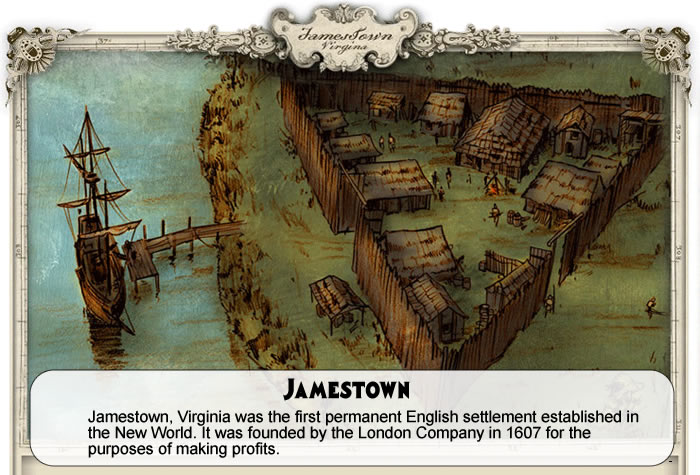First Permanent English Settlement
Despite the failure of the Lost Colony at Roanoke, King James I was eager to start a permanent English settlement in North America. He granted charters to a pair of English companies to establish those settlements. While one of the two companies was unsuccessful in establishing a colony in present-day Maine, the other, known as the London Company, led by captain Christopher Newport, sailed to Virginia and established a settlement on a swampy peninsula on the James River.
Unfit for Life in the Wilderness
While the chosen location certainly provided good cover from the potential ambushes of local Indians, its swampy climate led to horrible diseases such as Dysentery and Malaria. Jamestown further suffered from poor and corrupt leadership and a population of men that were unfit for life in the wilderness. Many were there for the opportunity to make a lot of money and refused to participate in building shelters or collecting food. Settlers constantly bickered with each other and found relatively little in the way of natural resources or wonders to send back to England.
John Smith's Power
Because Jamestown was built on traditional hunting grounds of the Algonkin Indians, trouble arose soon after their arrival. By the winter of 1607, only 38 out of the original 104 settlers were still alive. Food shortages were making unbearable situations even worse. Jamestown was on the brink of collapse until JOHN SMITH formulated plans to procure Indian corn and other foods via trade. Smith's first excursions were extremely successful, and he returned to the beleaguered colony with large quantities of corn and beans. On one of his excursions, however, he was ambushed by Indians and taken to the great king Powhatan. Smith used his charm and persuasion to convince Powhatan that the settlers were peaceful and did not intend to build a permanent settlement at Jamestown. Smith was subsequently returned to Jamestown and gained influence among the colonists.
 |
| Chief Powhatan |
Smith Becomes President of the Jamestown Council
In winter of 1608, Jamestown remained a desperate settlement with serious leadership problems and a food shortage. John Smith became hated by much of the so-called leadership. Despite at least one attempt on his life, Smith was named president of the Jamestown Council because of his previous experience and because he was one of the few colonists who knew what it took to survive at Jamestown.
The Life-Force of Jamestown
For the next year, Smith managed the colony about as well as it could be managed. He forced all colonists to work and contribute to the colony as a whole. He imposed badly-needed discipline and even staged shooting contests and drills to scare local Indians who were surely spying on them. Besides managing Jamestown, John Smith procured food from local Indians for European trinkets and goods. Despite Powhatan's demand for guns, John Smith refused to trade them, and often burned villages and stole food when Indians would not trade. Smith's power terrified the Indians, who came to think of him as virtually indestructible. Powhatan rightfully saw him as the life-force of Jamestown and sent his warriors on countless missions to kill him. While John Smith escaped death many times with firepower, Powhatan's daughter, the princess Pocahontas, took a special liking to him, and informed him in advance when her father would send warriors after him.
 |
| Captain John Smith |
Jamestown Colony Articles and Activities
13 Colonies Navigation
Other 13 Colonies Articles




